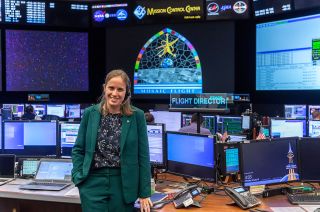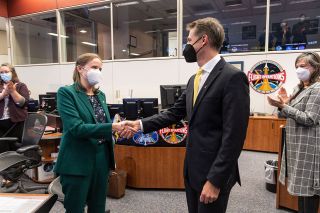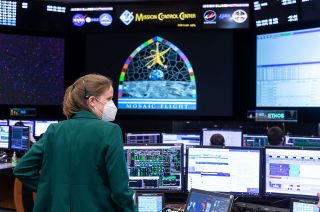Mosaic Flight: NASA's 100th flight director leads Mission Control
"It is humbling to look back at the fact that, in the history of human spaceflight, there's only been 99 people before me."

For over 60 years and more than 230 missions, teams of dedicated engineers and specialists in NASA's Mission Control have provided ground support for astronauts in space and on the moon. Out of the thousands of people who staffed the consoles and backroom support areas in that time, less than 100 have led the room.
That is until earlier this week, when Fiona Turett completed her first solo shift as NASA's 100th flight director.
"It's certainly an honor," said Turett in an interview with collectSPACE.com. "It is humbling to look back at the fact that in the history of human spaceflight, there's only been 99 people before me, and I'm the 100th person to be a flight director, and then just think about the influence that those 100 people have been able to have on the space program and to be a part of that."
"It's just a number in some ways, but I also think it's a really exciting time in NASA history, and having a landmark number to keep working towards the exciting things we have coming in the years ahead is pretty cool," she said.
A former safety and mission assurance officer for the final space shuttle missions, Turett previously served in mission control as a systems lead for the International Space Station and as a manager for the Gateway, a human-tended platform to be launched into lunar orbit as part of NASA's burgeoning Artemis program. She was chosen to become a flight director in February 2021 and underwent almost a year of training for the position together with three others preparing for the role.
"When my class was hired, there were four of us," said Turett. "We knew we would be numbers 98 through 101, so it was a little bit of happenstance that I happened to be the third of us to certify. It was just based on how we work through the [training] flow and our other tasking."
Related: NASA's Artemis program of lunar exploration
Get the Space.com Newsletter
Breaking space news, the latest updates on rocket launches, skywatching events and more!

As a flight director, Turett is now responsible for leading teams of flight controllers, astronauts, research and engineering experts and commercial and international partners around the world, as well as making real-time decisions critical to keeping NASA's crew members safe while in space.
Over the next year as she is fully certified, Turett will work about 100 shifts on console, double the typical amount she will do in the years after.
"That obviously helps the office with staffing, but it also really helps get our feet under us and get very comfortable with what working console as a flight director looks like," she said. "Then we start to get other assignments as as we go along."
Mosaic Flight
Turett officially became the 100th flight director while working an evening shift in the International Space Station control room. The crew had already gone to sleep, so most of the time was spent planning for upcoming days.
"Congratulations and thank you to Fiona Turett!" NASA astronaut Mark Vande Hei wrote on Twitter from on board the International Space Station on Tuesday (Jan. 11). "Last night and [in] the early hours of this morning, Fiona pulled her first shift as a fully-qualified NASA flight director, NASA's 100th! Congratulations on that huge accomplishment, and thank you for the huge responsibility you're taking on."
At the start of the shift, Turett was presented with her flight director's pin and then, following tradition, she revealed the name she chose for her team.
"I got a lot of suggestions for call signs related to century or centurion," she told collectSPACE.

Once spaceflights grew long enough to require flight controllers to work in shifts, NASA's early flight directors adopted colors to identify their teams. Chris Kraft, who invented the position as NASA's first flight director in 1960 (and, who in 2011 became the namesake of the Mission Control Center at Johnson Space Center in Houston, eight years before his death) was "Red Flight," while his three original appointees, John Hodge, Eugene Kranz and Glynn Lunney, used Blue, White and Black, respectively.
Colors were exclusively used up until the early 1980s, when the custom expanded to include constellation and star names (e.g. Aquila, Orion). As time went on, the naming devices grew to include gems, mythological figures and terms from space and flight history.
"A flight director's team name stays with that flight director forever," Ed Van Cise, Carbon Flight, wrote in a 2014 introduction to a list of the names. "It retires when that flight director leaves the office and is never reused."
Turett's two classmates who preceded her chose Adagio (Brandon Lloyd) and Horizon (Diane Dailey). When it was her turn, Turett chose "Mosaic."
"I wanted a call sign that did two things: first, spoke to me about how I got here and what kind of leader I wanted to be, and then secondly, I wanted a call sign that my teams could see themselves as," Turett said. "I saw the word 'Mosaic' somewhere and it was clear that was the idea that I wanted."
"The reason I chose Mosaic on the personal side — there are a lot of different people and experiences and places that have helped make me who I am today and I wanted to find a way to honor that all of the pieces are part of the flight director I am. And then for the team, around the world and in space who make human spaceflight possible, I wanted them to see that they each bring a piece that might not look that exciting on its own, but when you put it into this mosaic of the whole team, we are able to accomplish something much bigger than any one piece could on its own," she said.
In more recent years, flight directors have also had patches commemorating their team names and time on console. Turett's Mosaic Flight patch features a stained glass motif depicting Earth rising over the moon, with many of the colors used by past flight directors forming the border. It was designed by Turett working with artist Tim Gagnon, who has also created patches for past space shuttle and space station crews.
"The shape of the tiles are a mathematical pattern," Turett said, describing the patch. "Both of my parents are mathematicians, and so that's my ode to my family. And then the three stripes at the bottom are in honor of one of my personal heroes, Mother Teresa, and that's just a reminder that I'm here to serve."
Related: 'Gene Kranz Day' honors flight director, funds mission control revival
Flight history
The traditions within the flight directors office serve as a link between Turett and the 99 people who came before her, as does a set of tenets established early in the program.
"Chris Kraft and the early flight directors really did an amazing job of setting up what the role was," she said. "We have what we call the 'Foundations of Flight Operations.' It's a one-page document that talks about the qualities that we as flight directors and everyone who works in mission control need to have to succeed as a team."
"It's foundational to how we act and what is expected of us and anyone who works in the building," said Turett.
The role of the flight director has evolved in some ways over the years, in part due to the changes in how human spaceflight is achieved but also due to the increasing diversity within the office.

Out the 99 flight directors that preceded Turett, only 17 were women (the first, Linda Ham, Corona Flight, was chosen in 1991). Holly Ridings (Viking Flight) became the first woman to be named chief flight director in 2018.
"We really do have a diverse team, and I think there are a few benefits to that," Turett said. "The first one is that the more diversity of thought that you get, the more likely you are to have a team that can think of everything. I think diversity of thought comes [from] the diversity of experience and that goes into any kind of diversity, so it helps our team perform at our best."
"The other part, which which I think is equally important, is that a lot of people look at NASA — and the astronauts are more on TV and forefront than the flight directors are — but as an organization, a lot of people look at NASA, kids or other folks, and having a workforce that they can see themselves in is really important for helping inspire them to follow whatever dream they have," she said.
"The other part, which I think is equally important, is that a lot of people look at NASA — and the astronauts are more on TV and forefront than the flight directors are — but as an organization, a lot of people look at NASA, kids or other folks, and having a workforce that they can see themselves in is really important for helping inspire them to follow whatever dream they have," she said.
Five individuals have been named "honorary flight directors," in addition to the 100 that have now served officially in the role. Those honored include the chief of Apollo data priority coordination, Bill Tindall (Grey Flight); Gene Kranz' secretary, Lois Ransdell (Pink Flight); head secretary for the flight directors' office supporting the space shuttle program, Alene Ganzer (Diamond Flight); director of the mission operations directorate, John O'Neill (Scarlet Flight); and Apollo-era flight controller and unofficial mission control historian, Bob Legler (History Flight).
The first family members to both serve as a flight directors were Glynn and Bryan Lunney, who led their first shifts in 1963 and 2000, respectively. Bryan honored his father's legacy as Black Flight by selecting the team name "Onyx."
The first (and only) astronaut to trade his helmet for a headset, Timothy "TJ" Creamer (Saber Flight), became a flight director in 2015 after logging 163 days on the International Space Station.
One more member of Turett's 2021 flight director class, Chloe Mehring, is still to serve her first solo shift and reveal her team name. When she does, she will bring the total number of active flight directors in the office to 25.
In December, NASA concluded its most recent recruitment for new flight directors. Candidates had to be U.S. citizens with a bachelor's degree from an accredited institution in engineering, biological science, physical science, computer science or mathematics. They also needed "substantial related, progressively responsible professional experience." NASA plans to announce selections in the spring.
Click through to collectSPACE to see a full list of NASA's first 100 flight directors and their chosen team names.
Follow collectSPACE.com on Facebook and on Twitter at @collectSPACE. Copyright 2021 collectSPACE.com. All rights reserved.
Join our Space Forums to keep talking space on the latest missions, night sky and more! And if you have a news tip, correction or comment, let us know at: community@space.com.

Robert Pearlman is a space historian, journalist and the founder and editor of collectSPACE.com, an online publication and community devoted to space history with a particular focus on how and where space exploration intersects with pop culture. Pearlman is also a contributing writer for Space.com and co-author of "Space Stations: The Art, Science, and Reality of Working in Space” published by Smithsonian Books in 2018. He previously developed online content for the National Space Society and Apollo 11 moonwalker Buzz Aldrin, helped establish the space tourism company Space Adventures and currently serves on the History Committee of the American Astronautical Society, the advisory committee for The Mars Generation and leadership board of For All Moonkind. In 2009, he was inducted into the U.S. Space Camp Hall of Fame in Huntsville, Alabama. In 2021, he was honored by the American Astronautical Society with the Ordway Award for Sustained Excellence in Spaceflight History.

